Contents
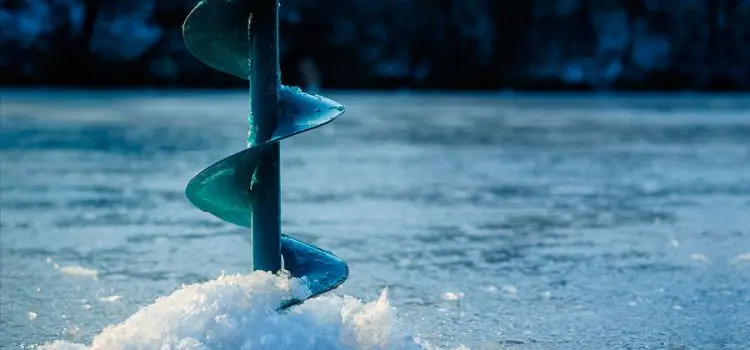
Some anglers, after the end of the summer fishing season, switch to the winter season. Despite the fact that ice fishing has its own specifics, it brings no less pleasure than summer fishing. The only thing is that fishing on ice requires some security measures from the angler, since very dire consequences are possible.
In this case, everything is related to the thickness of the ice. If you do not take into account the thickness of the ice, then you can easily fall through the ice, and then drown, which happens quite often. Sometimes anglers drive cars onto the ice, after which they have to pull out both the anglers and their cars.
Quite often, anglers do not take into account the thickness of the ice, especially in spring, and end up on torn off ice floes. Therefore, going to a reservoir, it is desirable to know how thick the ice is on it at the moment. This is easy to determine if the weather has been frosty for several days.
And, nevertheless, on the reservoir you should always check the thickness of the ice. Unfortunately, not all anglers know what thickness of ice is safe.
The beginning of ice formation on water bodies
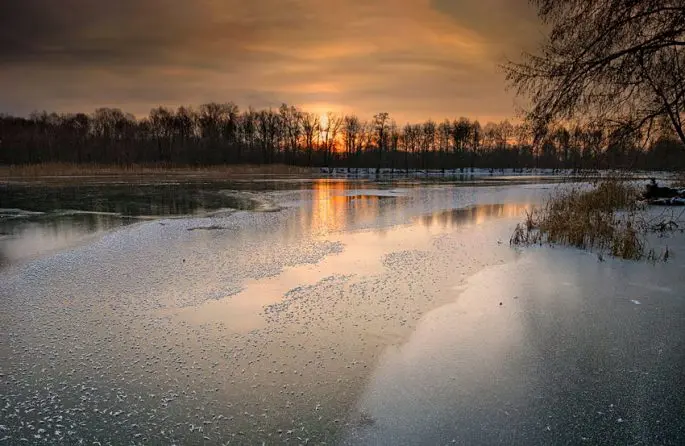
As a rule, ice on our reservoirs begins to appear in late autumn. By the end of November or the beginning of December, ice is formed that can withstand a person. Unfortunately, a lot depends on weather conditions, as there are cold and warm autumns. Sometimes ice in the month of December only appears on water bodies, and it happens that by the beginning of November the ice already closes all water bodies. If we take into account the reservoirs located closer to the northern latitudes, then ice appears there very early, and by the middle of winter you can safely drive on it. By this period, official ice roads begin to operate, allowing you to cross various water bodies until the very spring.
Therefore, you must always be aware of all events, including the temperature regime.
Optimal ice thickness for fishing
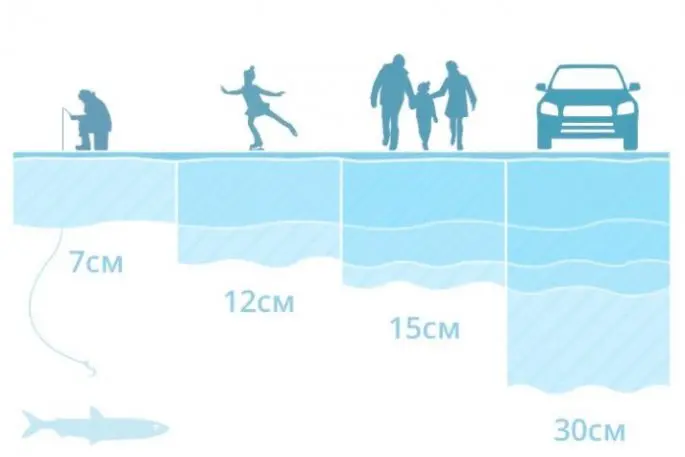
It is believed that you can safely go out on the ice if its thickness is equal to not less than 7 cm, but the guaranteed thickness is considered to be the thickness of ice from 10 centimeters.
Places where it is officially allowed to cross a reservoir from one bank to another must have a thickness of at least 15 centimeters.
Vehicles are allowed to drive on the ice provided that the ice thickness is not less than 30 centimeters.
At the same time, it should immediately be noted that the thickness of the ice on the reservoir can be different. This is due to the presence of undercurrents, which are invariably present on large lakes, in sections of rivers where bends are observed, and also in places where sewerage merges.
Signs of fragile ice
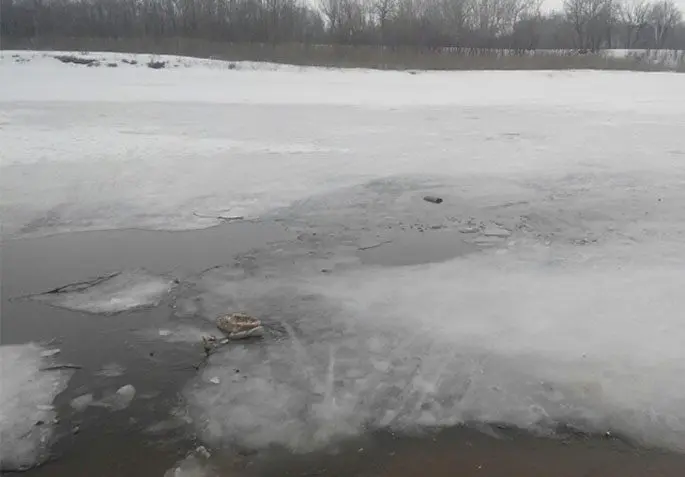
There are external signs by which it is easy to determine the fragility of ice. It is dangerous to go out on the ice if:
- The ice looks loose and porous, white in color.
- If water flows out of the wells.
- The characteristic sounds of crackling and squelching are heard.
- Ice covered with snow can also be dangerous.
In any case, you should take a pick with you on a fishing trip and use it to check suspicious areas.
“Safety”: Dangerous Ice
Methods for checking ice thickness
Upon arrival at the reservoir, it is necessary to immediately check the thickness of the ice, if there are suspicions that it is not thick enough. How it’s done:
- First, the appearance of the ice cover should be assessed. If the ice is even, without cracks and has a bluish tint, then this ice is able to withstand a person.
- If the ice, after being moved on it, makes a crack or bends, then it is better not to go out onto such ice.
- The first time on the ice you need to step very carefully.
- If you tap on the ice with a stick and it crackles, or if water appears on the surface, it means that it is very thin and it is dangerous to go out on it.
- If you managed to walk a considerable distance and only then it was discovered that the ice might not hold, it is better to lie down on the ice, spread your legs wide and crawl towards the shore.
Ways to travel on ice
By ski
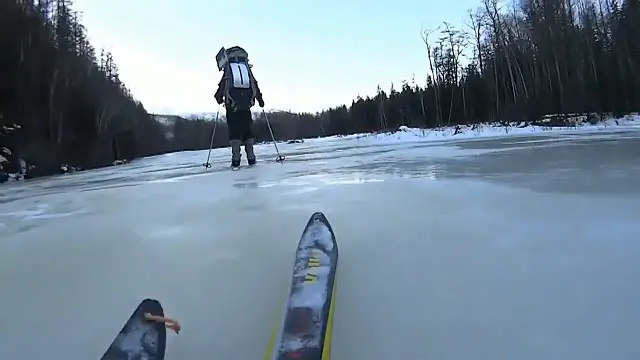
Some anglers who go fishing by public transport or have to leave their car on the shore move across the ice on skis. In such cases, the thickness of the ice must be at least 8 centimeters.
It should also be noted that skiing on clear ice is not very comfortable. It is better if there is not a large layer of snow on the ice.
On snowmobiles
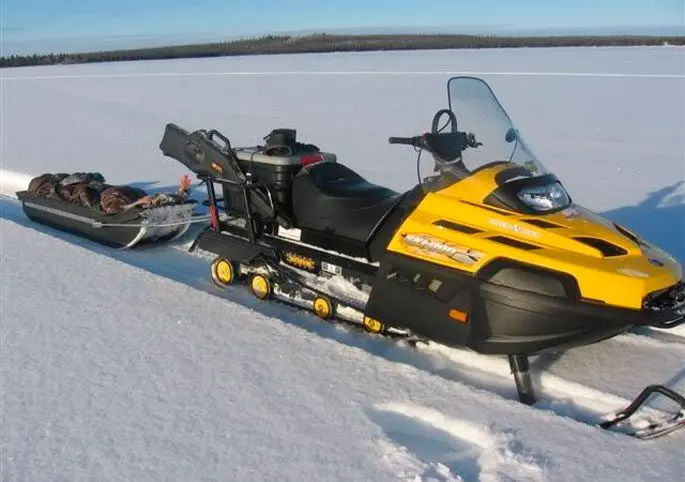
On this type of transport, you can move on ice if its thickness is at least 15 centimeters. As a rule, a snowmobile is used when there is already a guaranteed thickness of ice. It is also very important for a snowmobile that there is some layer of snow.
Legalized ice crossings
Such crossings exist in conditions where there are no corresponding roads connected with bridges. They help to reduce, and quite significantly, the distances between settlements. Vehicles are also allowed on these crossings. The thickness of the ice is at least 30 centimeters.
Usually such crossings are accepted by special state commissions, with the participation of representatives of local authorities and employees of the GIMS of the Ministry of Emergency Situations. They drill holes and measure the thickness of the ice. If the data allow organizing the crossing, then the existing authorities give permission for this.
Dangerous areas of ice on water bodies in winter
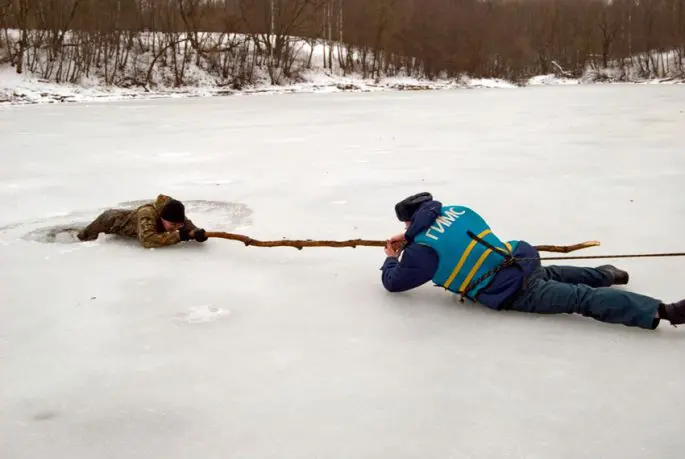
- The most dangerous ice can be in autumn, when it is just beginning to form, and in early spring, when it has already begun to melt.
- As a rule, the ice is thicker near the banks of the river than in its middle.
- Of particular danger is ice covered with a thick layer of snow or snowdrifts. Under the thickness of the snow, it is almost impossible to determine the thickness of the ice.
- Ice-holes, polynyas, as well as fishing holes are no less dangerous. Passing through such a site, you can easily and unexpectedly fall through the ice.
- Ice becomes dangerous during periods of thaw, when it turns white and becomes loose, soft and porous. It is very dangerous to go out on such ice.
- Sufficiently dangerous places are located in areas where swampy terrain is noted. Usually, very thin ice is possible in such areas, due to the gases that are released. They, as it were, heat up the ice from below, therefore, it is better to bypass such places, even if there are severe frosts outside.
Ice Fishing Safety Precautions

Going on winter fishing, you should follow some rules that can protect any angler from unforeseen situations. Here they are:
- Before you stand on the ice, you should decide on its strength.
- It is better to move on the ice with well-found paths: if a person has passed here before, then it is safe here.
- If there are no traces of a person’s movement across the reservoir, then you can move forward only after checking the strength of the ice. It can be a stick, and even better if it is a pick.
- If you find water on the ice or hear a characteristic crack, you must immediately go back.
- It is not advisable to approach areas where there are many fishermen. Excess weight can cause the ice to crack.
- It is better not to go fishing in adverse weather conditions such as fog, rain or snowfall. It is also not recommended to go out on the ice at night.
- You should not approach polynyas, ice holes and dangerous areas, especially those where there is a rapid current.
- You should not engage in such frivolous things as ice skating.
- Do not test the strength of the ice by kicking or jumping.
When moving on ice, additional weight should also be taken into account. Anglers usually carry significant personal weight due to layered and warm clothing, as well as additional weight associated with fishing gear. Particular attention should be paid to the moments when it is decided to go to the ice by car or other means of transport.
In case the ice fell through

There are some recommendations for such cases when the ice falls through and the angler finds himself in the water. Unfortunately, such cases are not uncommon. In order not to drown, you must:
- Firstly, you should not panic and throw off things that do not allow you to get on the ice. You need to stay afloat and loudly call for help.
- With both hands, you should rest against the edge of the ice, and also take off your shoes if water has already accumulated in them.
- All actions should be aimed at not breaking off the edge of the ice.
- If the reservoir is not deep, then you can try to push off with your feet from the bottom to get out onto the ice. If the ice is too thin, then you can break it and slowly move towards the shore.
- If the depth is significant, then you can try to get out onto the ice in the following way: lean on the ice with your chest and try to pull first one and then the other leg onto the ice.
- At the sight of a drowning person, you should give him a stick or throw a rope, after which you should crawl towards the drowning person.
- If a group of fishermen fell through the ice, then one should get out of the water in turn, helping each other, remaining on the ice in a lying position.
- Actions must be fast, otherwise you can get hypothermia, which is no less dangerous. If the victim managed to be pulled ashore, then he should immediately be given something to drink and always hot. After that, it is advisable to remove wet clothes from him and call an ambulance.
Winter fishing is an interesting and exciting activity. If you follow the recommendations and adhere to a number of rules, then winter fishing will be remembered only from the good side. It will be possible not only to catch fish, but also to breathe clean air, recharged with energy until the next weekend.
How to get out of the hole. The danger of the first thin ice









